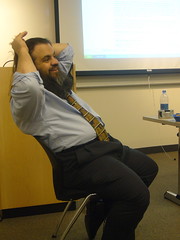
Alexander Technique
"How many times a day do you tweet?" asked Bryan Alexander, Director of Research at the National Institute for Technology and Liberal Education, a non-profit initiative dedicated to promoting liberal education.
"Six to ten times," the student responded.
No, this isn't bird school.
Guest speaker Alexander was simply talking about www.twitter.com, a site that encourages individuals to communicate and stay connected through the exchange of brief, frequent answers to the question "What are you doing?" These exchanges are known by those who use the site as "tweets."
Alexander is definitely a frequent tweeter. Even as he lectured us on pedagogy and Web 2.0., tweets of various hellos from around the world scrolled on the projected computer screen behind him.
The long-haired, bearded technology buff was visiting USF from his home in snowy rural Vermont, where he conducts research primarily on mobile and wireless computing, digital gaming, and social software. "It's fun to lecture on 3D technology and then go off and chop wood for an hour," Alexander said.
One area of particular interest to Alexander is "ARG": Alternate Reality Gaming. An Alternate Reality Game is an interactive narrative that uses the real world as a platform, often involving multiple media and game elements, to tell a story that may be affected by participants' ideas or actions. The first two Alternate Reality Games, according to Christy Dena in her essay 'Emerging Participatory Culture Practices: Player-Created Tiers in Alternate Reality Games', were Microsoft Game Studio's The Beast and Electronic Arts Majestic. In his lecture, Alexander also mentioned www.ilovebees.com, Perplex City, and World Without Oil as good examples of Alternate Reality Gaming.
Reflecting his easy-going approach to technology, Alexander followed discussion of "Connectivism" (G. Siemens, 2004) and "Wikipedagogies" by taking us to the Web 2.0 Bullshit Generator.
"Web 2.0 is easier than web 1.0," he said.
If that's true, then I should have no problem disintermediating my A-list web services and designing social folksonomies later this week.







No comments:
Post a Comment